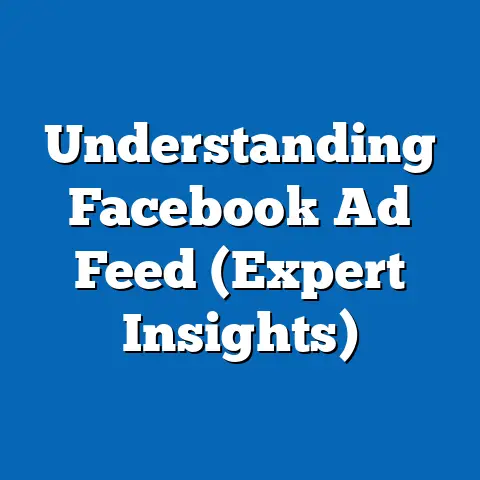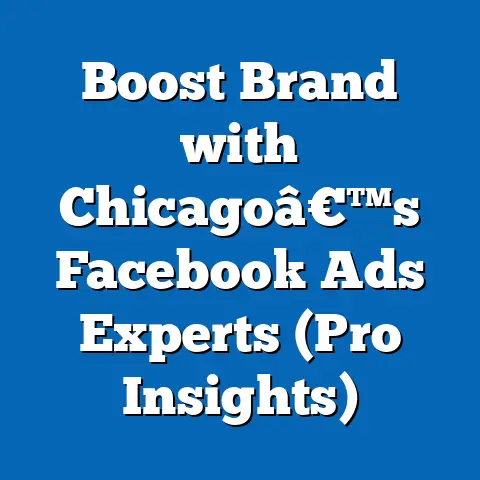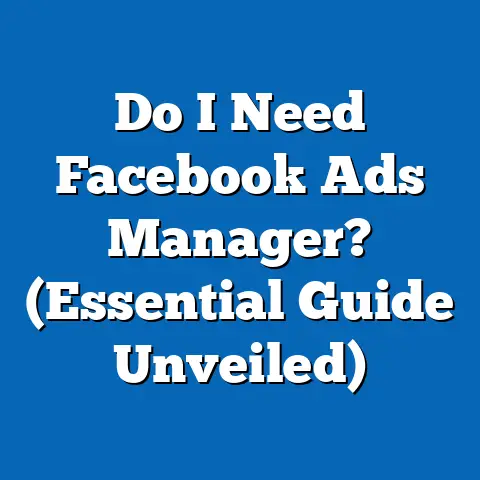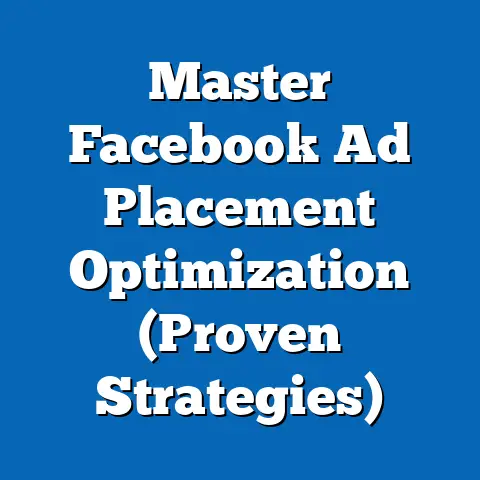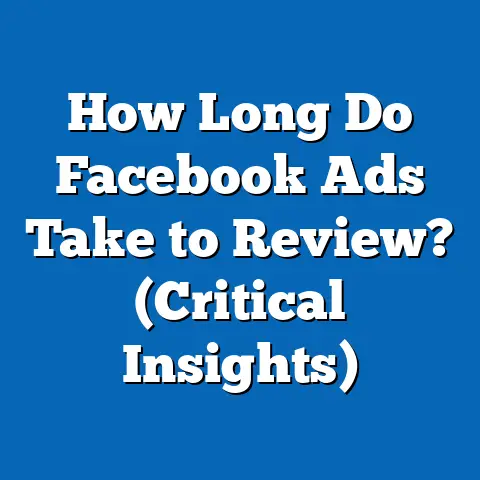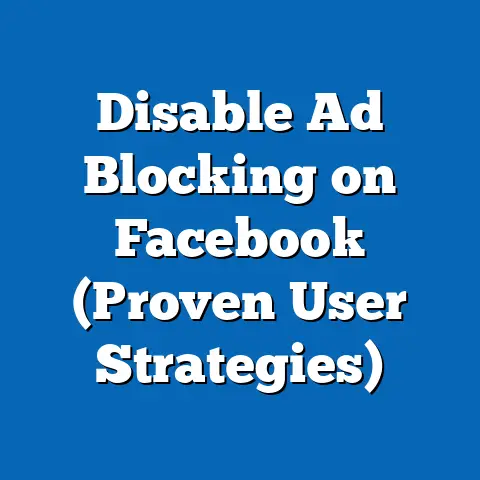Fix Adblock Issues on Facebook Ads (Expert Solutions)
The world of digital advertising is a constantly evolving landscape, a relentless chase for attention in a sea of information. As marketers, we’re always striving to connect with our target audience, to deliver the right message at the right time. But what happens when our carefully crafted ads are blocked, unseen, and unheard? This is the reality many of us face, thanks to the rise of ad blockers.
Ad blockers, those seemingly innocuous browser extensions and mobile apps, have become increasingly popular, and for good reason. They promise a cleaner, faster, and more private browsing experience. As users, I understand the appeal – who wants to be bombarded with irrelevant ads? But as a marketer, I also understand the frustration. Ad blockers can significantly impact the effectiveness of Facebook advertising campaigns, potentially derailing even the most well-planned strategies.
Understanding Adblock Technology
To effectively combat the impact of ad blockers, it’s crucial to first understand what they are, how they work, and why they’ve become so prevalent. Ad blockers are essentially software applications or browser extensions designed to prevent advertisements from appearing on web pages. They work by identifying and blocking elements on a webpage that match known patterns and characteristics of advertisements.
How Ad Blockers Function:
The core functionality of ad blockers revolves around a few key techniques:
- Filter Lists: Ad blockers rely heavily on filter lists, which are essentially databases of known ad servers, ad networks, and specific ad-related URLs. These lists are constantly updated by communities and organizations dedicated to fighting intrusive advertising. When a webpage loads, the ad blocker checks its elements against these filter lists. If a match is found, the element is blocked from loading.
- HTML Element Blocking: Ad blockers can also identify and block specific HTML elements commonly used in advertisements, such as
<iframe>tags or elements with specific class names or IDs associated with ad placements. - Script Blocking: Many ads rely on JavaScript code to function. Ad blockers can prevent these scripts from running, effectively disabling the ad’s functionality.
- Cosmetic Filtering: Some ad blockers go beyond simply blocking ads and offer cosmetic filtering, which removes empty spaces or visual remnants left behind after an ad has been blocked, further cleaning up the user’s browsing experience.
Types of Ad Blockers:
Ad blockers come in various forms, each with its own strengths and weaknesses:
- Browser Extensions: These are the most common type of ad blocker, available for popular browsers like Chrome, Firefox, Safari, and Edge. Examples include AdBlock, Adblock Plus, uBlock Origin, and Ghostery.
- Mobile Applications: Ad blockers are also available as standalone apps for mobile devices, often working by creating a VPN connection that filters out ad traffic before it reaches the device.
- Built-in Browser Features: Some browsers are now incorporating ad-blocking functionality directly into their settings, offering users a built-in solution without the need for external extensions or apps.
- Network-Level Ad Blocking: These solutions operate at the network level, blocking ads for all devices connected to a particular network. This is often implemented in routers or through specialized DNS servers.
Usage Statistics:
The prevalence of ad blockers is significant and continues to grow. According to recent reports, hundreds of millions of people worldwide use ad blockers regularly. This number has been steadily increasing over the years, driven by growing concerns about privacy, security, and the overall user experience on the web.
Why Users Install Ad Blockers:
Understanding the motivations behind ad blocker usage is crucial for developing effective strategies to overcome their impact. Here are some key reasons why users choose to install ad blockers:
- Privacy Concerns: Many users are concerned about the tracking and data collection practices associated with online advertising. Ad blockers help to prevent advertisers from collecting data about their browsing habits.
- User Experience Preferences: Intrusive and annoying ads can significantly degrade the browsing experience. Ad blockers eliminate these distractions, allowing users to focus on the content they’re interested in.
- Content Overload: The sheer volume of ads on some websites can be overwhelming. Ad blockers help to reduce this clutter, making it easier for users to navigate and consume content.
- Security Concerns: Malicious ads, known as malvertising, can pose a security threat to users. Ad blockers can help to prevent these ads from loading, reducing the risk of infection.
- Faster Page Loading Times: Ads can slow down page loading times, especially on mobile devices. Ad blockers can improve browsing speed by preventing these resource-intensive elements from loading.
- Data Consumption: Ads, especially video ads, can consume a significant amount of data, particularly on mobile devices with limited data plans. Ad blockers can help to reduce data consumption by preventing these ads from loading.
Impact of Ad Blockers on Facebook Ads:
Facebook, despite its sophisticated advertising platform, is not immune to the effects of ad blockers. While Facebook has implemented various measures to circumvent ad blockers, they still have a noticeable impact on ad visibility and engagement rates.
- Reduced Reach: Ad blockers directly reduce the reach of Facebook ads, preventing them from being seen by a significant portion of the target audience.
- Lower Engagement Rates: Even if an ad manages to bypass an ad blocker, users who are predisposed to blocking ads may be less likely to engage with them.
- Inaccurate Reporting: Ad blockers can skew advertising metrics, making it difficult to accurately assess the performance of campaigns. For example, impressions may be underreported, leading to an inaccurate calculation of click-through rates (CTR).
Takeaway: Understanding how ad blockers work and why users install them is the first step in developing effective strategies to mitigate their impact on Facebook advertising campaigns. By addressing the underlying concerns that drive ad blocker usage, marketers can increase the likelihood of reaching their target audience and achieving their advertising goals. Next, we’ll explore the specific ways ad blockers affect Facebook ads and the implications for different types of businesses.
The Adblock Effect on Facebook Advertising
Now that we have a solid understanding of adblock technology, let’s dive deeper into its specific impact on Facebook advertising. Ad blockers don’t discriminate – they block ads across the board, and that includes the ads we painstakingly create on Facebook.
How Ad Blockers Affect Different Types of Facebook Ads:
The impact of ad blockers can vary depending on the type of Facebook ad being used:
- Image Ads: These are the simplest form of Facebook ads, consisting of a single image, headline, and description. Ad blockers often target these ads by blocking the image URL or the HTML elements associated with the ad.
- Video Ads: Video ads can be particularly resource-intensive and intrusive, making them a prime target for ad blockers. Ad blockers may block the video file itself or the scripts used to play the video. I’ve noticed that video ads that autoplay are more likely to be blocked than those that require user interaction.
- Carousel Ads: Carousel ads display multiple images or videos in a scrollable format. Ad blockers can block individual items within the carousel or the entire carousel container.
- Collection Ads: Collection ads are designed for e-commerce businesses, showcasing a collection of products with a visual layout. Ad blockers can block the images, product descriptions, or the entire collection ad unit.
- Lead Ads: Lead ads are designed to collect lead information directly within Facebook. Ad blockers may block the form elements or the scripts used to process the lead data.
- Instant Experience Ads (formerly Canvas Ads): These full-screen, mobile-optimized ads offer an immersive experience. Ad blockers can block various elements within the Instant Experience, such as images, videos, and call-to-action buttons.
Implications for Different Business Types:
The impact of ad blockers can also vary depending on the type of business and its advertising goals:
- Small Startups: Startups often rely heavily on Facebook advertising to reach a wider audience and build brand awareness. Ad blockers can significantly hinder their ability to achieve these goals, especially with limited budgets.
- E-commerce Businesses: E-commerce businesses use Facebook ads to drive traffic to their online stores and generate sales. Ad blockers can reduce the number of potential customers who see their ads, impacting revenue. I’ve seen firsthand how a sudden increase in ad blocker usage can lead to a noticeable dip in sales for e-commerce clients.
- Large Corporations: While large corporations have larger advertising budgets and a more diversified marketing strategy, ad blockers can still impact their reach and brand perception.
- Non-profit Organizations: Non-profit organizations often use Facebook ads to raise awareness for their cause and solicit donations. Ad blockers can limit their ability to reach potential donors and supporters.
Real-World Case Studies:
Let’s look at some real-world examples of businesses that have faced challenges due to ad blockers:
- Case Study 1: E-commerce Startup: A small e-commerce startup selling handmade jewelry noticed a significant drop in website traffic and sales after a popular ad blocker gained widespread adoption. They initially struggled to understand the cause of the decline, but after analyzing their Facebook advertising data, they realized that a large portion of their target audience was using ad blockers. They responded by shifting their focus to organic content marketing and influencer collaborations, which helped them to regain some of their lost traffic and sales.
- Case Study 2: Local Restaurant: A local restaurant was running Facebook ads to promote their daily specials and attract new customers. However, they discovered that many of their target audience members were using ad blockers, preventing them from seeing the ads. They decided to experiment with creating more engaging and visually appealing ad content, focusing on high-quality photos of their food and highlighting customer testimonials. This resulted in a significant increase in ad engagement and a reduction in the impact of ad blockers.
- Case Study 3: Software Company: A software company was using Facebook ads to generate leads for their sales team. However, they found that many of their lead ads were being blocked by ad blockers. They decided to switch to a value-driven approach, offering free resources and webinars in exchange for lead information. This resulted in a higher quality of leads and a lower reliance on traditional ad formats.
Psychological Effects of Ad Blockers on Consumer Behavior:
Ad blockers not only impact ad visibility but also influence consumer behavior and brand perception. Users who actively choose to block ads may have a negative perception of advertising in general. This can make it more challenging to reach them, even with non-intrusive ad formats.
- Increased Skepticism: Ad blocker users may be more skeptical of advertising claims and less likely to trust brands that rely heavily on traditional advertising methods.
- Negative Brand Association: Some users may associate brands that use intrusive or annoying advertising tactics with negative experiences, leading to a decline in brand loyalty.
- Shift in Consumer Expectations: The rise of ad blockers has contributed to a shift in consumer expectations, with users demanding more control over their online experience and a greater emphasis on privacy and transparency.
Takeaway: Ad blockers have a multifaceted impact on Facebook advertising, affecting ad visibility, engagement rates, and consumer behavior. Understanding these effects is essential for developing effective strategies to mitigate their impact and achieve advertising goals. Now that we understand the problem, it’s time to explore the solutions. Let’s move on to discussing actionable strategies and expert solutions for overcoming adblock issues on Facebook Ads.
Expert Solutions to Fix Adblock Issues
Now for the heart of the matter: how do we, as marketers, navigate this ad-blocking world and still reach our target audience effectively? The good news is, there are several actionable strategies we can implement to minimize the impact of ad blockers on our Facebook advertising campaigns. It’s not about trying to trick or circumvent ad blockers; it’s about adapting our approach to be more user-friendly, value-driven, and respectful of user preferences.
3.1: Adjusting Ad Targeting Strategies
One of the most effective ways to mitigate the impact of ad blockers is to refine our audience targeting strategies. The goal is to reach users who are less likely to use ad blockers in the first place. This requires a granular approach and a deep understanding of our target audience.
- Focus on Specific Demographics and Interests: Instead of targeting broad demographics, narrow down your audience based on specific interests, behaviors, and demographics that are less likely to be associated with ad blocker usage. For example, users who are interested in technology and privacy may be more likely to use ad blockers.
- Exclude Ad Blocker Users (If Possible): While Facebook doesn’t provide a direct targeting option to exclude ad blocker users, you can use third-party data and insights to identify segments of your audience that are more likely to be using ad blockers. You can then exclude these segments from your targeting.
- Target Mobile Users: Mobile ad blocker usage is generally lower than desktop usage. By focusing your advertising efforts on mobile users, you can increase the likelihood of reaching your target audience. I’ve found that mobile-optimized video ads tend to perform well, especially when they’re short, engaging, and relevant to the user’s interests.
- Experiment with Different Placements: Facebook offers a variety of ad placements, including the News Feed, Right Column, Instagram, Audience Network, and Messenger. Some placements may be more susceptible to ad blockers than others. Experiment with different placements to identify those that perform best with your target audience. I often test different placements using A/B testing to see which ones yield the highest reach and engagement.
- Leverage Custom Audiences: Custom Audiences allow you to target users based on your own data, such as email lists or website visitors. These users are already familiar with your brand and may be more receptive to your ads, even if they use ad blockers.
- Lookalike Audiences: Lookalike Audiences allow you to target users who are similar to your existing customers or website visitors. These users may share similar interests and behaviors, making them more likely to be interested in your products or services.
3.2: Creating Value-Driven Content
Another crucial strategy is to focus on creating ads that provide real value to users. If your ads are perceived as helpful, informative, or entertaining, users may be less likely to block them. This requires a shift in mindset from simply trying to sell products or services to providing valuable content that resonates with your target audience.
- Focus on Solving Problems: Identify the pain points and challenges that your target audience faces and create ads that offer solutions. For example, if you’re selling project management software, create ads that highlight how your software can help users to improve their productivity and collaboration.
- Provide Useful Information: Share informative content that is relevant to your target audience’s interests. For example, if you’re selling fitness equipment, create ads that share tips on how to stay healthy and fit.
- Entertain Your Audience: Create ads that are funny, engaging, or visually appealing. For example, if you’re selling a travel package, create ads that showcase stunning destinations and exciting activities.
- Tell a Story: Use storytelling to connect with your audience on an emotional level. Share stories about your brand, your customers, or the impact that your products or services have on people’s lives.
- Use High-Quality Visuals: Invest in professional-quality photos and videos that are visually appealing and relevant to your target audience. Avoid using stock photos that look generic or unauthentic.
- Write Compelling Ad Copy: Craft ad copy that is clear, concise, and persuasive. Highlight the benefits of your products or services and use a strong call to action.
- Personalize Your Ads: Use personalization to tailor your ads to individual users based on their interests, behaviors, and demographics. This can increase the relevance and engagement of your ads.
3.3: Leveraging Native Advertising Techniques
Native advertising is a form of advertising that blends seamlessly with the surrounding content, making it less intrusive and more likely to be seen by users. By adopting native advertising techniques, you can minimize the chances of your ads being filtered out by ad blockers.
- Create Ads That Look and Feel Like Organic Content: Design your ads to resemble the organic content that users typically see in their News Feed. Use similar fonts, colors, and layouts.
- Focus on Providing Value Rather Than Selling: Instead of directly promoting your products or services, focus on providing valuable information or entertainment that is relevant to your target audience.
- Use Clear and Concise Language: Avoid using overly promotional or salesy language. Instead, use clear and concise language that is easy to understand.
- Be Transparent About Sponsorship: Clearly disclose that your content is sponsored or promoted. This will help to build trust with your audience.
- Partner with Influencers: Collaborate with influencers who have a strong following and a trusted voice in your target audience. Influencer marketing can be a highly effective way to reach ad blocker users, as their content is often perceived as more authentic and less intrusive than traditional advertising.
3.4: Utilizing Facebook’s Own Tools and Features
Facebook offers a variety of tools and features that can help to mitigate the impact of ad blockers. By leveraging these tools, you can increase the visibility and engagement of your ads.
- Instagram Stories Ads: Instagram Stories ads are full-screen, mobile-optimized ads that appear between users’ Stories. These ads are less likely to be blocked by ad blockers than traditional News Feed ads. I’ve found that short, visually appealing video ads perform particularly well in Instagram Stories.
- Messenger Ads: Messenger ads appear in users’ Messenger inboxes. These ads can be a highly effective way to reach users who are actively engaged in conversations.
- Audience Network: The Audience Network allows you to extend your Facebook advertising campaigns to other websites and apps. While ad blockers can still impact ads served through the Audience Network, Facebook has implemented measures to minimize their impact.
- Branded Content Ads: Branded Content ads allow you to partner with creators and influencers to promote your brand. These ads are often perceived as more authentic and less intrusive than traditional advertising.
- Collaborative Ads: Collaborative Ads allow you to partner with retailers to promote your products on Facebook. These ads are often more relevant to users and can drive higher conversion rates.
3.5: Encouraging Whitelisting
Whitelisting is the process of allowing ads from a specific website or advertiser to be displayed, even when an ad blocker is enabled. While it may seem like a long shot, encouraging users to whitelist your ads can be an effective way to reach them.
- Explain the Benefits of Viewing Ads: Be transparent with your audience about the benefits of viewing ads. Explain that ads help to support the content and services that they enjoy.
- Offer Incentives: Offer incentives to users who whitelist your ads, such as exclusive content, discounts, or early access to new products.
- Make it Easy to Whitelist: Provide clear and easy-to-follow instructions on how to whitelist your ads.
- Use a Polite and Respectful Tone: Avoid using aggressive or demanding language. Instead, use a polite and respectful tone that acknowledges the user’s right to choose whether or not to view ads.
- Focus on Building Trust: Build trust with your audience by providing valuable content, being transparent about your advertising practices, and respecting their privacy.
3.6: Monitoring and Adapting to Trends
The world of ad blocking is constantly evolving. New ad blockers are being developed, and existing ad blockers are being updated with new features and techniques. It’s essential to stay informed about these trends and adapt your strategies accordingly.
- Monitor Ad Blocker Usage: Track the usage of ad blockers among your target audience. This will help you to understand the impact of ad blockers on your advertising campaigns.
- Stay Informed About New Ad Blocker Technologies: Keep up-to-date on the latest ad blocker technologies and techniques. This will help you to anticipate and respond to changes in the ad blocking landscape.
- Adapt Your Strategies: Be prepared to adapt your strategies as needed. What works today may not work tomorrow.
- Test and Experiment: Continuously test and experiment with different advertising strategies to identify those that are most effective in reaching ad blocker users.
Takeaway: Overcoming adblock issues on Facebook Ads requires a multifaceted approach that involves adjusting targeting strategies, creating value-driven content, leveraging native advertising techniques, utilizing Facebook’s own tools and features, encouraging whitelisting, and monitoring and adapting to trends. It’s not a one-size-fits-all solution, but rather a continuous process of experimentation and optimization. Next, we’ll discuss how to measure the impact of the solutions you implement and refine your strategies accordingly.
Measuring the Impact of Solutions
Implementing the strategies outlined above is just the first step. To truly understand their effectiveness, we need to measure their impact and refine our approach based on the data. This involves tracking relevant metrics and KPIs, conducting A/B testing, and using the insights gained to optimize our Facebook advertising campaigns.
- Reach: Track the reach of your ads to see how many users are actually seeing them. A decrease in reach may indicate that your ads are being blocked by ad blockers.
- Impressions: Monitor the number of impressions your ads are generating. Impressions represent the number of times your ads are displayed.
- Click-Through Rate (CTR): Calculate the CTR of your ads by dividing the number of clicks by the number of impressions. A lower CTR may indicate that your ads are not resonating with your target audience.
- Conversion Rate: Track the conversion rate of your ads by dividing the number of conversions by the number of clicks. A lower conversion rate may indicate that your landing page is not optimized for conversions.
- Cost Per Acquisition (CPA): Calculate the CPA of your ads by dividing the total cost of your campaign by the number of acquisitions. A higher CPA may indicate that your campaign is not cost-effective.
- Return on Ad Spend (ROAS): Calculate the ROAS of your ads by dividing the revenue generated by your campaign by the total cost of your campaign. A higher ROAS indicates that your campaign is generating a good return on investment.
A/B Testing:
A/B testing is a powerful technique for comparing different versions of your ads to see which ones perform best. By A/B testing different ad formats, targeting options, and ad copy, you can identify the strategies that are most effective in overcoming adblock issues.
- Test Different Ad Formats: Experiment with different ad formats, such as image ads, video ads, carousel ads, and Instant Experience ads, to see which ones are less likely to be blocked by ad blockers.
- Test Different Targeting Options: Try different targeting options, such as demographic targeting, interest-based targeting, and custom audiences, to see which ones are most effective in reaching ad blocker users.
- Test Different Ad Copy: Experiment with different ad copy to see which messages resonate best with your target audience.
- Test Different Call-to-Actions: Try different call-to-actions to see which ones are most likely to drive conversions.
Tools and Resources:
There are a variety of tools and resources available to help you track ad performance and user engagement:
- Facebook Ads Manager: Facebook Ads Manager provides a comprehensive set of tools for creating, managing, and tracking your Facebook advertising campaigns.
- Google Analytics: Google Analytics allows you to track website traffic and user behavior, providing valuable insights into the effectiveness of your advertising campaigns.
- Third-Party Analytics Tools: There are a variety of third-party analytics tools available that can provide more detailed insights into ad performance and user engagement.
Takeaway: Measuring the impact of your solutions is crucial for optimizing your Facebook advertising campaigns and achieving your advertising goals. By tracking relevant metrics, conducting A/B testing, and using the insights gained to refine your strategies, you can minimize the impact of ad blockers and maximize your ROI.
Conclusion
In conclusion, ad blockers pose a significant challenge to Facebook advertisers, impacting ad visibility, engagement rates, and consumer behavior. However, by understanding the technology behind ad blockers, their motivations, and their effects on Facebook ads, marketers can take proactive steps to mitigate their impact and achieve their advertising goals.
Throughout this guide, we’ve explored a range of expert solutions for overcoming adblock issues on Facebook Ads, including:
- Adjusting Ad Targeting Strategies: Refining your audience targeting to reach users who are less likely to use ad blockers.
- Creating Value-Driven Content: Designing ads that provide real value to users, reducing the likelihood of being blocked.
- Leveraging Native Advertising Techniques: Creating ads that blend seamlessly with users’ feeds, minimizing the chances of being filtered out by ad blockers.
- Utilizing Facebook’s Own Tools and Features: Leveraging Facebook’s features that can help mitigate adblock impacts, such as using Instagram Stories, Messenger ads, and other innovative ad placements.
- Encouraging Whitelisting: Providing strategies for encouraging users to whitelist your ads, including transparent communication about the benefits of viewing ads.
- Monitoring and Adapting to Trends: Staying informed about new adblock technologies and trends, and adapting strategies accordingly.
I encourage you to take proactive steps to implement these expert solutions in your Facebook advertising campaigns. Remember that adapting to the digital landscape is crucial for sustained success. The world of digital advertising is constantly evolving, and the challenges posed by ad blockers are likely to persist. However, by embracing innovation, creativity, and a user-centric approach, we can overcome these challenges and continue to connect with our target audience in meaningful ways.
The future of digital advertising lies in building trust, providing value, and respecting user preferences. By embracing these principles, we can create a more sustainable and effective advertising ecosystem that benefits both businesses and consumers. So, let’s move forward with confidence, knowing that we have the tools and knowledge to navigate the ad-blocking world and achieve our advertising goals. And remember, the most important tool we have is our ability to adapt, learn, and innovate in this ever-changing digital landscape.

